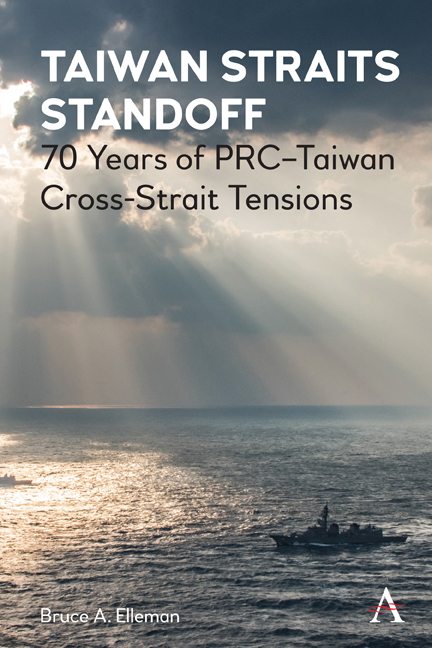Book contents
- Frontmatter
- Dedication
- Contents
- List of Illustrations
- Introduction: Stalemate along the Taiwan Straits, 1949–2020
- 1 The Two Chinas and the Battle for Control of Offshore Islands
- 2 President Harry S. Truman’s Decision to Protect Taiwan
- 3 The First Taiwan Strait Crisis, 1954–55
- 4 The Evacuation of the Dachen Islands, 1955
- 5 The Second Taiwan Strait Crisis, 1958
- 6 The US Threat to Use Atomic Weapons
- 7 Using Taiwan to Undermine the Sino-Soviet Alliance
- 8 Taiwan during the Cold War and Afterward
- Conclusions: The Taiwan Strait’s Strategic Significance Today
- Appendix: Naval Terms and Acronym List
- Selected Bibliography
- Index
6 - The US Threat to Use Atomic Weapons
- Frontmatter
- Dedication
- Contents
- List of Illustrations
- Introduction: Stalemate along the Taiwan Straits, 1949–2020
- 1 The Two Chinas and the Battle for Control of Offshore Islands
- 2 President Harry S. Truman’s Decision to Protect Taiwan
- 3 The First Taiwan Strait Crisis, 1954–55
- 4 The Evacuation of the Dachen Islands, 1955
- 5 The Second Taiwan Strait Crisis, 1958
- 6 The US Threat to Use Atomic Weapons
- 7 Using Taiwan to Undermine the Sino-Soviet Alliance
- 8 Taiwan during the Cold War and Afterward
- Conclusions: The Taiwan Strait’s Strategic Significance Today
- Appendix: Naval Terms and Acronym List
- Selected Bibliography
- Index
Summary
To most outside observers, the opposing forces facing each other across the Taiwan Strait during the early 1950s may have seemed unevenly matched on the side of the United States and its allies. However, asymmetric warfare can give advantages to both sides. For example, China's enormous manpower allowed it to send “human waves” in the Korean War against its United Nation's opponent. Therefore, the possibility of being forced to use atomic weapons was seriously discussed, in particular against an approaching surface and subsurface invasion force aimed at Taiwan.
During the early 1950s, atomic bombs were often thought of much like regular bombs. The use of the A-bomb was considered in Korea, and later in Vietnam during the Dien Bien Phu crisis. With regard to Taiwan, during July 1950 Truman authorized the movement of B-29 bombers to Guam. These planes were capable of carrying atomic bombs. Meanwhile, an air unit in Guam was given control of non-radioactive atomic bomb components, with the nuclear core to be provided only during an emergency. This information was leaked to the New York Times so as to give the PRC pause before they decided to attack Taiwan.
During times of crisis, planning sessions often included discussion on using atomic bombs. For example, on September 12, 1954, the NSC submitted a Top Secret paper discussing the ongoing Taiwan Strait crisis. It warned that a war with China over the offshore islands would necessarily include a sharp rise in tensions that could “probably lead to our initiating the use of atomic weapons.” Clearly, the use of atomic weapons was considered to be an important element in the defense of Taiwan.
Consideration of the nuclear option
It is still unclear whether the US government would have actually used Abombs in Korea or to halt a PRC invasion of Taiwan. In 1950, MacArthur evidently told Harriman during their talks on August 6–8 that if there were a PRC attack against Taiwan then Seventh Fleet ships, fighter jets from the Philippines and Okinawa, B-29s, and other aircraft could destroy any invasion attempt that might be made. He further stated that it would be a one-sided battle: “Should the Communists be so foolhardy as to make such an attempt, it would be the bloodiest victory in Far East history.”
- Type
- Chapter
- Information
- Taiwan Straits Standoff70 Years of PRC–Taiwan Cross-Strait Tensions, pp. 109 - 120Publisher: Anthem PressFirst published in: 2021

